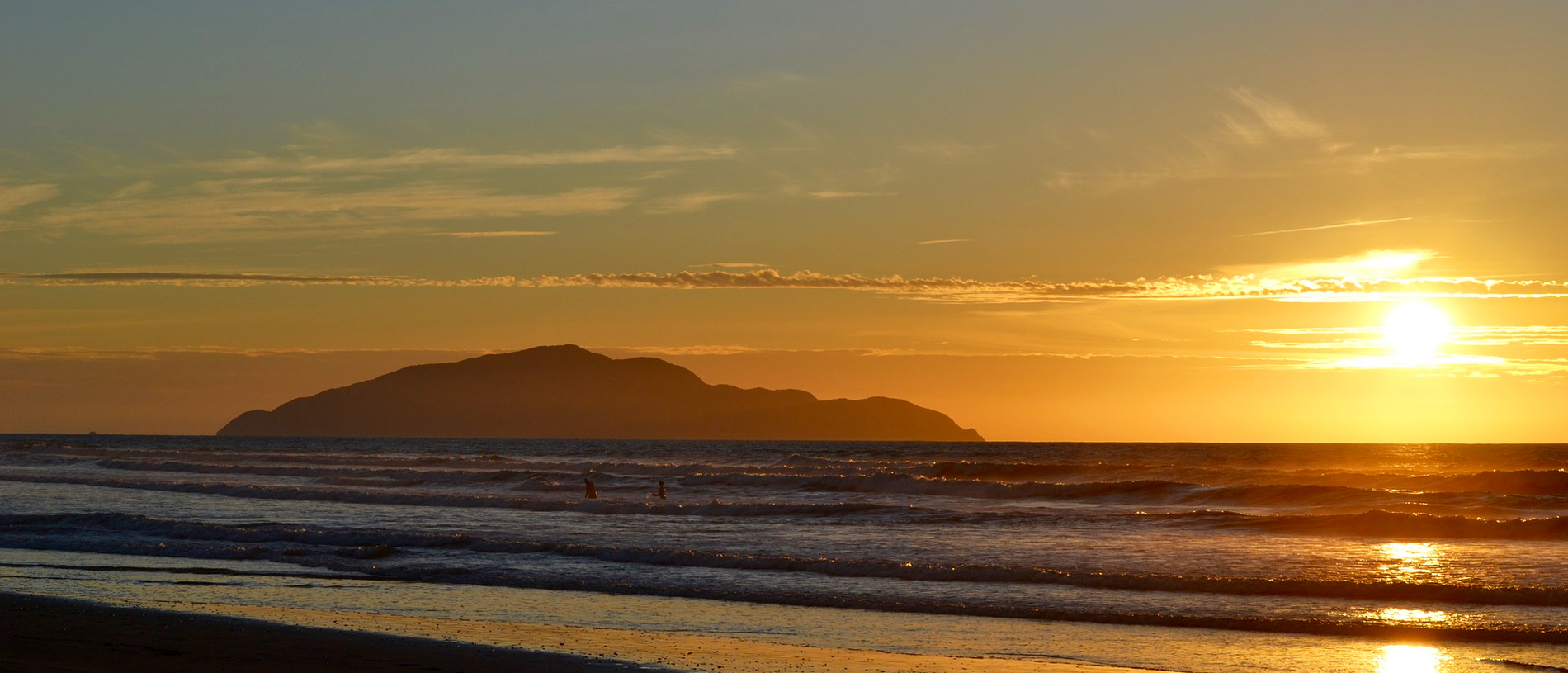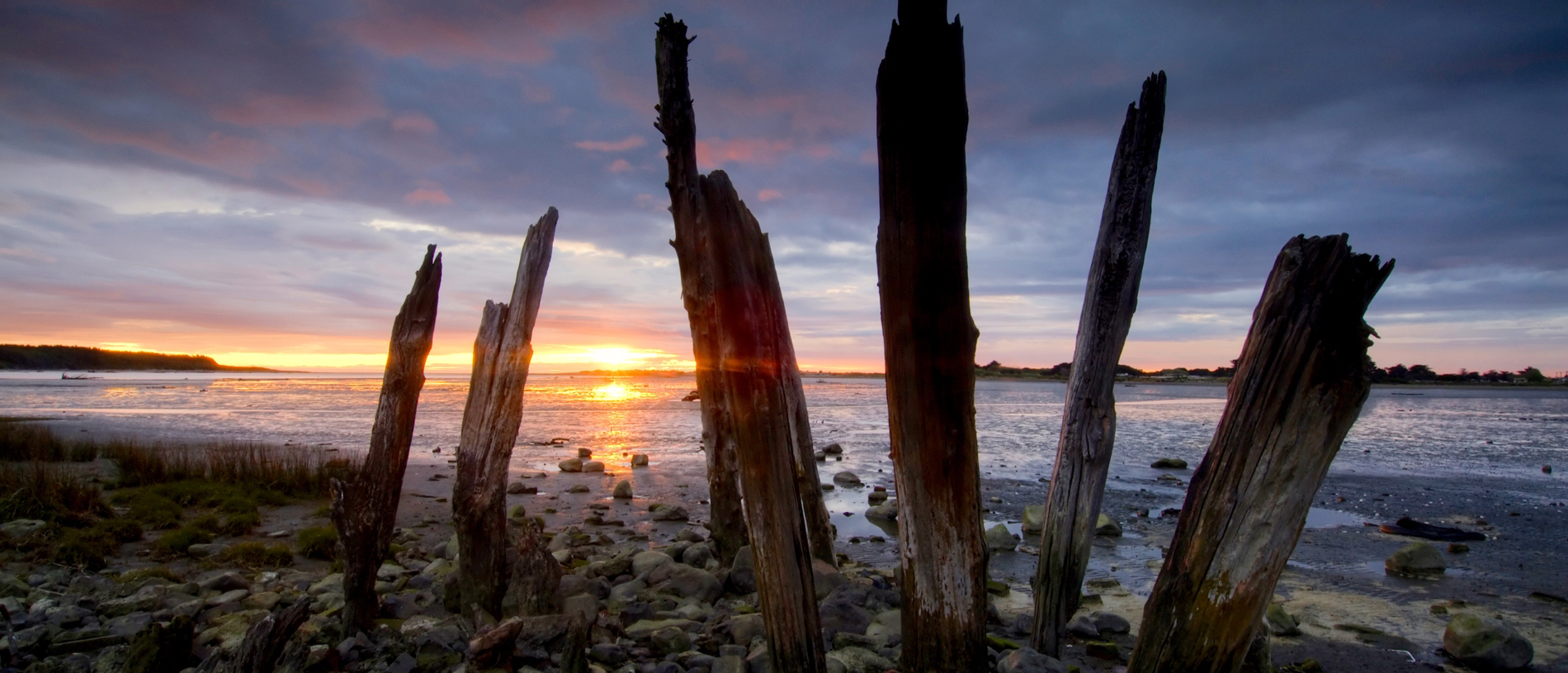
Kāpiti Coast: from frowning bluffs to ancient rivers
Throughout history, and still to this day, the Kāpiti Coast has remained one of the best places in New Zealand to watch the sunset.

Horowhenua once used to have a slogan that advertised the district as ‘the feel of real New Zealand.’
This was probably once accurate, assuming you consider New Zealand to be pretty mushy, overall.
For Horowhenua was historically a very large swamp, essentially the floodplains of the Manawatū River. It was a wetland, carpeted in flax with the odd stand of podocarp forest for variety. Māori knew it as ‘shaking earth’ (the translation of the district’s name), which either refers to the frequent earthquakes or to the wobbly, swampy ground. Māori were established in the district basically forever, exploiting the kaimoana resources of the river mouth and the birdlife of the wetlands and using the Manawatū River as a highway inland.
The marginal river mouth port at Foxton was the main point of contact for the district with the outside world until the Wellington Manawatū Railway Company pushed its line through in 1886. After this, the port went into a bit of a decline due to the dangerous bar at its entrance and the constant silting that accelerated as the land in the Manawatū River catchment was cleared.
The port's death-knell came when the loop of the Manawatū River where the town was built was cut off in an event that is still subject to local conspiracy theories. In 1943, the government was nearly finished major works to protect Foxton from the flooding of the Manawatū, when a flood pre-empted its completion. The torrent that flowed down one of the spillways was so great, the river couldn’t be persuaded to resume its old course. Foxton residents believed – and believe – that the Whirokino Cut Disaster was no accident. There is the occasional talk of cutting a channel through to the river to restore the town loop, but it is unlikely to succeed. After all, the river calls the shots.
Horowhenua was subject to three major flax booms, but by the end of World War One, flax was no longer a payable commodity. Today, Foxton boasts a Flax Stripper Museum, which gives an insight into this once-crucial but now-forgotten industry, and the little town of Tokomaru has a steam engine museum, commemorating the Wellington Manawatū Railway Company era and subsequent developments. Levin (named for WMR director, William Hort Levin) is not exactly synonymous with culture (although the good folk at the Horowhenua Arts Centre will disagree) but at Murrayfield, a few kilometres inland, you can see Clydesdale draught-horses in action – the tractor of their day, these gentle giants (literally) provided the horsepower with which much of New Zealand agriculture and construction got done, back in the day.
The entire stretch of coast from Ōtaki to Hīmatangi offers hard, flat sand beaches with good swimming (due caution must be exercised, and the best spots (Foxton, Waitārere Beach) are patrolled in summer: swim between the flags!) and surf-casting.
The kite and wind-surfing are good along here, and in the right conditions, boating and boat-borne fishing are popular. Beachcombing opportunities are just about endless (the beach was once the main road route between Wellington and Whanganui, with ferries plying the rivers), and on Waitarere Beach, you can find the remains of the Hydrabad, a steel vessel wrecked here in 1878. She was once quite a photo opportunity, standing proud of the sand, but now there are only a few hull members and plates to be seen.
On the other edge of the district, the Tararua Ranges are a playground for trampers and hunters alike.
If you’re passing through on State Highway One, a good place to rest, water the children and wear them out is the Levin Domain, where there is an excellent adventure playground complete with a miniature railway. If you’ve gone the other way, just north of Shannon is Owlcatraz, a native bird and wildlife sanctuary that opened in 1997. Besides the Steam Engine Museum, Tokomaru is also the site of the regular gatherings, as they are called, of bowmen from the lower North Island, so if the twang of bowstrings and the hiss of well-fledged shafts is your thing, this is the place to be.
For some reason or another, Foxton has a working example of a Dutch windmill. The de Molen (the name means ‘the Mill’) windmill was opened in 2003, realising the dream of a Dutch resident of Foxton who drew up the plans thirty-odd years previously when he still imagined he could grow tulips in the Foxton and create a little slice of the Netherlands in the Horowhenua. He was disappointed, but the mill is there, and it works. You can even buy the stoneground flour it produces. You can also enjoy Dutch fare in the Dutch Oven (no, it’s not what you think: it’s a bakery and café) and shop for Dutch produce at the Dutch Market nearby.
Foxton has an annual fair, which is a major event on the local calendar and draws visitors from all over the lower North Island. It is a companion event to the Levin A&P show, one of the best examples of this icon of the New Zealand rural way of life and a great day out from Wellington or wherever you happen to hail from.
It’s probably just a coincidence, but the Dutch are great lovers of licorice, and while you could buy some authentic stuff from the Dutch Market in Foxton, you could also buy some authentic Kiwi licorice from RJ’s Licorice in Levin. You’ll have heard of them. In order to celebrate their 21st birthday, RJs recently staged a successful bid to create the world’s largest licorice allsort. For the record, it weighed in at 1100 kg, and they’ve probably got some left over.
Up the road in Foxton, another quirky little business is Foxton Fizz, a soda factory that dates back to 1918. It was recently resurrected and while it no longer manufactures its products in the character-filled old building in Foxton (production has shifted to the aerated water capital of New Zealand, Putāruru), their products are still sold here.
But perhaps the best-known feature of Horowhenua’s culinary landscape is its local produce. The district is the market gardening powerhouse of the lower North Island, and there are roadside stalls selling top quality fruit and vegetables everywhere. You can pick your own berries, or eat some that someone else has picked for you at Shirley’s Strawberries just south of Levin.
An inordinate number of politicians seem to have hailed from Horowhenua, but on the positive side, there have been a couple of former and current All Blacks greats, too: Carlos Spencer was a Horowhenua and Manawatū rep long before he became a Rangitoto Yank, and 2017 All Black squad member Codie Taylor is from here, too. The Horowhenua can also boast New Zealand children’s literary treasure, Joy Cowley.